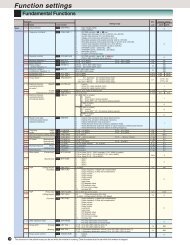Create successful ePaper yourself
Turn your PDF publications into a flip-book with our unique Google optimized e-Paper software.
15. <strong>Appendix</strong><br />
(3) Anti-noise devices<br />
To reduce the noise propagated through the electrical circuits and the noise radiated from the main<br />
circuit wiring to the air, a line filter and power supply transformer are utilized (refer to Figure 10).<br />
Among line filters, there are the simple type filters, such as a capacitive filter connected in parallel to<br />
the power supply line and an inductive filter connected in series to the power supply line, as well as<br />
orthodox filters (LC filters). These filters are used according to the targeted effect for reducing noise.<br />
In power supply transformers, there are common insulated transformers, shielded transformers, noisecut<br />
transformers, etc. These transformers have different effectiveness in blocking noise propagation.<br />
(a) Capacitive filter (b) Inductive filter (c) LC filter<br />
(zero-phase reactor or ferrite ring)<br />
Figure 10 Various Filters and their Connection Methods<br />
(4) Noise prevention measures on the receiving side<br />
It is important to strengthen the noise immunity of those electronic devices installed in the same<br />
control panel as the inverter and/or located near the inverter.<br />
Line filters and shielded or twisted shielded wire is used to block the penetration of noise in the signal<br />
lines of these devices. The following treatments are also implemented.<br />
1) The circuit impedance is lowered by connecting capacitors or resistors to the input and output<br />
terminals of the signal circuit in parallel.<br />
2) The circuit impedance for noise is increased by inserting choke coils in series in the signal circuit, or,<br />
passing the signal through ferrite core beads.<br />
It is also effective to widen the signal base line (0 V line) or grounding line.<br />
(5) Other<br />
The generating (propagating) level of noise changes with the carrier frequency of the inverter, the<br />
higher the carrier frequency, the higher the generated level of noise.<br />
In the case of an inverter for which the carrier frequency can be changed, lowering the carrier<br />
frequency can reduce the generation of electrical noise and result in a good balance with the audible<br />
noise of the motor under driving conditions.<br />
15-7



